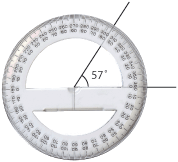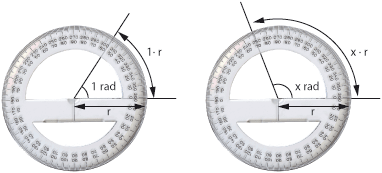4.1 Angles and circles
From Förberedande kurs i matematik 1
| Theory | Exercises |
Contents:
- Various angle measures (degrees and radians)
- Pythagoras' theorem
- Formula for distance in the plane
- Equation of a circle
Learning outcomes:
After this section, you will have learned :
- To convert between degree and radians.
- To calculate the area and circumference of sectors of a circle.
- The features of right-angled triangles.
- To formulate and use Pythagoras' theorem.
- To calculate the distance between two points in the plane.
- To sketch circles by completing the square.
- The concepts of the unit circle, tangent, radius, diameter, circumference, chord and arc.
- To solve geometric problems that contain circles.
Angle measures
There are several different units for measuring angles, which are used in different contexts. The two most common within mathematics are degrees and radians.
- Degrees. If a complete revolution is divided into 360 parts, then each part is called 1 degree. Degrees are designated by \displaystyle {}^\circ.
- Radians. Another way to measure an angle is to consider an arc described by the angle, and simply divide the length of this arc by its radius. This unit is called the radian. A full circle is \displaystyle 2\pi radians, since the circumference of a circle is \displaystyle 2\pi r, where \displaystyle r is its radius.
A complete circle is \displaystyle 360^\circ or \displaystyle 2\pi radians which means
\displaystyle \begin{align*}
&1^\circ = \frac{1}{360} \times 2\pi\ \mbox{ radians }
= \frac{\pi}{180}\ \mbox{ radians,}\\
&1\ \mbox{ radian } = \frac{1}{2\pi} \times 360^\circ
= \frac{180^\circ}{\pi}\,\mbox{.}
\end{align*}
|
These conversion relations can be used to convert between degrees and radians.
Example 1
- \displaystyle 30^\circ = 30 \times 1^\circ = 30 \times \frac{\pi}{180}\ \mbox{ radians } = \frac{\pi}{6}\ \mbox{ radians }
- \displaystyle \frac{\pi}{8}\ \mbox { radians } = \frac{\pi}{8} \times (1 \; \mbox{radian}\,) = \frac{\pi}{8} \times \frac{180^\circ}{\pi} = 22\mbox{.}5^\circ
In some contexts, it may be useful to talk about negative angles and angles greater than 360°. This means that the same point on the circle can be designated by different angles that differ from each other by a whole number of complete revolutions.
![[Image]](/wikis/2009/bridgecourse1-ImperialCollege/img_auth.php/metapost/a/d/b/adb5d2a7377ac4e092456d9ca65e66a3.png)
Example 2
- The angles \displaystyle -55^\circ and \displaystyle 665^\circ
indicate the same point on the circle because
\displaystyle -55^\circ + 2 \times 360^\circ = 665^\circ\,\mbox{.} - The angles \displaystyle \frac{3\pi}{7} and \displaystyle
-\frac{11\pi}{7} indicate the same point on the circle because
\displaystyle \frac{3\pi}{7} - 2\pi = -\frac{11\pi}{7}\,\mbox{.} - The angles \displaystyle 36^\circ and \displaystyle
216^\circ do not specify the samepoint on the circle, but opposite points since
\displaystyle 36^\circ + 180^\circ = 216^\circ\,\mbox{.}
Formula for distance in the plane
Pythagoras' theorem is one of the most famous statements in the whole of mathematics; it says that in a right-angled triangle with legs (that is, short sides) \displaystyle a and \displaystyle b, and hypotenuse \displaystyle c then \displaystyle a^2 + b^2 = c^2.
Pythagoras' theorem:
|
|
Example 3
Consider the triangle on the right. Then
and therefore the hypotenuse \displaystyle c is equal to
|
|
Pythagoras' theorem can be used to calculate the distance between two points in a coordinate system.
Formula for distance:
The distance \displaystyle d between two points with coordinates \displaystyle (x,y) and \displaystyle (a,b) is
| \displaystyle d = \sqrt{(x – a)^2 + (y – b)^2}\,\mbox{.} |
The line joining the points is the hypotenuse of a triangle whose legs are parallel to the coordinate axes.
![[Image]](/wikis/2009/bridgecourse1-ImperialCollege/img_auth.php/metapost/b/2/6/b26ce49791aa401bb74412d49e5ba4f4.png)
The legs of the triangle have lengths equal to the difference in the x- and y-directions of the points, that is \displaystyle |x-a| and \displaystyle |y-b|. Pythagoras' theorem then gives the formula for the distance.
Example 4
- The distance between \displaystyle (1,2) and \displaystyle (3,1) is
\displaystyle d = \sqrt{ (1-3)^2 + (2-1)^2} = \sqrt{(-2)^2 + 1^2} = \sqrt{ 4+1} = \sqrt{5}\,\mbox{.} - The distance between \displaystyle (-1,0) and \displaystyle (-2,-5) is
\displaystyle d = \sqrt{ (-1-(-2))^2 + (0-(-5))^2} = \sqrt{1^2 + 5^2} = \sqrt{1+25} = \sqrt{26}\,\mbox{.}
Circles
A circle consists of all the points that are at a given fixed distance \displaystyle r from a point \displaystyle (a,b).
![[Image]](/wikis/2009/bridgecourse1-ImperialCollege/img_auth.php/metapost/0/6/2/06282cc22b3fe6eeea36613925ce586b.png)
The distance \displaystyle r is called the circle's radius and the point \displaystyle (a,b) is its centre. The figure below shows the other important concepts.
|
|
|
|
| |||
| Diameter | Tangent | Chord | Secant | |||
|
|
|
|
| |||
| Arc of a circle | Circumference | Sector of a circle | Segment of a circle |
Example 5
A sector of a circle is shown in the figure on the right.
|
|
- The way radians have been defined means that the arc length is simply the radius multiplied by the angle measured in radians, so that the arc length is
\displaystyle 3 \times \frac{5\pi}{18}\ \mbox{units } = \frac{5\pi}{6}\ \mbox{ units . }
- Determine the area of the circle segment.
The segment's share of the entire circle is\displaystyle \frac{50^\circ}{360^\circ} = \frac{5}{36}and this means that its area is \displaystyle \frac{5}{36} parts of the circle area, which is \displaystyle \pi r^2 = \pi 3^2 = 9\pi. Hence the area is
\displaystyle \frac{5}{36} \times 9\pi\ \mbox{ units }= \frac{5\pi}{4}\ \mbox{ units. }
A point \displaystyle (x,y) lies on the circle that has its centre at \displaystyle (a,b) and radius \displaystyle r, if its distance from the centre is equal to \displaystyle r. This condition can be formulated with the distance formula.
Circle equation:
|
|
Example 6
|
|
|
|
|
|
Example 7
- Does the point \displaystyle (1,2) lie on the circle \displaystyle (x-4)^2 +y^2=13?
Inserting the coordinates of the point \displaystyle x=1 and \displaystyle y=2 in the circle equation, we have that\displaystyle \begin{align*} \mbox{LHS } &= (1-4)^2+2^2\\ &= (-3)^2+2^2 = 9+4 = 13 = \mbox{RHS}\,\mbox{.} \end{align*}Since the point satisfies the circle equation it lies on the circle.
![[Image]](/wikis/2009/bridgecourse1-ImperialCollege/img_auth.php/metapost/c/2/b/c2b604362bebb4cb5d5959a822a50d9b.png)
- Determine the equation for the circle that has its centre at \displaystyle (3,4) and goes through the point \displaystyle (1,0).
Since the point \displaystyle (1,0) lies on the circle, the radius of the circle must be equal to the distance of the point from \displaystyle (1,0) to the centre \displaystyle (3,4). The distance formula allows us to calculate that this distance is\displaystyle c = \sqrt{(3-1)^2 + (4-0)^2} = \sqrt{4 +16} = \sqrt{20} \, \mbox{.}The circle equation is therefore
\displaystyle (x-3)^2 + (y-4)^2 = 20 \; \mbox{.} ![[Image]](/wikis/2009/bridgecourse1-ImperialCollege/img_auth.php/metapost/2/e/7/2e78c8b92478416492f4a0953246469b.png)
Example 8
Determine the centre and radius of the circle with equation \displaystyle \ x^2 + y^2 – 2x + 4y + 1 = 0.
Let us try to write the equation in the form
| \displaystyle (x – a)^2 + (y – b)^2 = r^2 |
because then we can directly read from this that the centre is \displaystyle (a,b) and the radius is \displaystyle r.
Start by completing the square for the terms containing \displaystyle x on the left-hand side
\displaystyle
\underline{x^2-2x\vphantom{(}} + y^2+4y + 1
= \underline{(x-1)^2-1^2} + y^2+4y + 1
|
The underlined terms shows the terms involved.
Now complete the square for the terms containing \displaystyle y
\displaystyle
(x-1)^2-1^2 + \underline{y^2+4y} + 1
= (x-1)^2-1^2 + \underline{(y+2)^2-2^2} + 1\,\mbox{.}
|
The left-hand side is therefore equal to
| \displaystyle (x-1)^2 + (y+2)^2-4 . |
Rearranging we see that the original equation is equivalent to
| \displaystyle (x-1)^2 + (y+2)^2 = 4 \, \mbox{.} |
From this we can easily see that the centre is \displaystyle (1,-2) and the radius is \displaystyle \sqrt{4}= 2.
![[Image]](/wikis/2009/bridgecourse1-ImperialCollege/img_auth.php/metapost/7/b/2/7b2d3a06ca4d11646449b1541cdab526.png)
Study advice
The basic and final tests
After you have read the text and worked through the exercises, you should do the basic and final tests to pass this section. You can find the link to the tests in your student lounge.
Keep in mind that...
Reviews
For those of you who want to deepen your understanding or need more detailed explanations consider the following references:
Learn more about Pythagoras theorem from Wikipedia
Read more about the circle on the Mathworld website
Useful web sites
Interactive experiments: the sine and cosine on the unit circle (Flash)


![[Image]](/wikis/2009/bridgecourse1-ImperialCollege/img_auth.php/metapost/7/2/9/7297c9bc30e68c93394025b132182670.png)
![[Image]](/wikis/2009/bridgecourse1-ImperialCollege/img_auth.php/metapost/d/2/f/d2ff7df26ceb7ecc6fab9646b919d9dd.png)
![[Image]](/wikis/2009/bridgecourse1-ImperialCollege/img_auth.php/metapost/8/2/1/821b8a352c39f6b69318c96ec25a84e7.png)
![[Image]](/wikis/2009/bridgecourse1-ImperialCollege/img_auth.php/metapost/2/3/e/23e1cbb7c8b731963ffa4aeda821b277.png)
![[Image]](/wikis/2009/bridgecourse1-ImperialCollege/img_auth.php/metapost/a/2/7/a27e381d480493ba0cb77e460cd17758.png)
![[Image]](/wikis/2009/bridgecourse1-ImperialCollege/img_auth.php/metapost/4/a/5/4a54d959f82763e83e41a86ad60933d2.png)
![[Image]](/wikis/2009/bridgecourse1-ImperialCollege/img_auth.php/metapost/b/2/0/b20d39083d55d8fe6e7454c1815f021b.png)
![[Image]](/wikis/2009/bridgecourse1-ImperialCollege/img_auth.php/metapost/f/a/4/fa48ec8305ef998ba790a540ab326c6f.png)
![[Image]](/wikis/2009/bridgecourse1-ImperialCollege/img_auth.php/metapost/5/c/9/5c9f453cdf00df1693557161cc6fceb4.png)
![[Image]](/wikis/2009/bridgecourse1-ImperialCollege/img_auth.php/metapost/a/f/d/afd624e400bff836280c119ab4cb970a.png)
![[Image]](/wikis/2009/bridgecourse1-ImperialCollege/img_auth.php/metapost/4/7/e/47e696fd84f13fed85b1394795a31875.png)
![[Image]](/wikis/2009/bridgecourse1-ImperialCollege/img_auth.php/metapost/c/1/b/c1b9fe94e84310b947c2f12983ec753d.png)
![[Image]](/wikis/2009/bridgecourse1-ImperialCollege/img_auth.php/metapost/1/a/4/1a4fb90a0e677a995867186eb909f5b5.png)
![[Image]](/wikis/2009/bridgecourse1-ImperialCollege/img_auth.php/metapost/b/2/1/b2185b3d2e88d185bc40539702f21363.png)
![[Image]](/wikis/2009/bridgecourse1-ImperialCollege/img_auth.php/metapost/4/d/e/4de1b674a9d9f670007e817471136f91.png)
